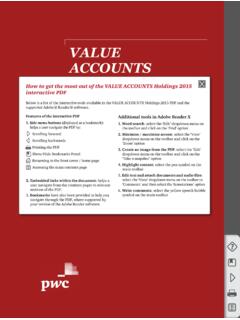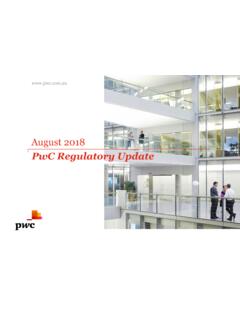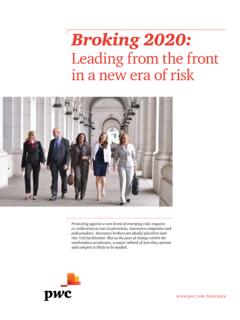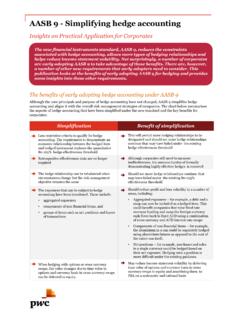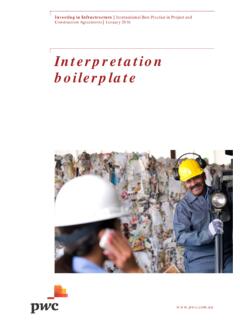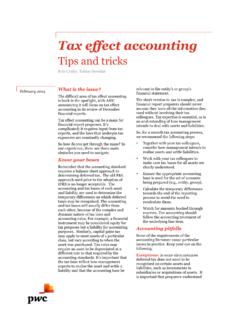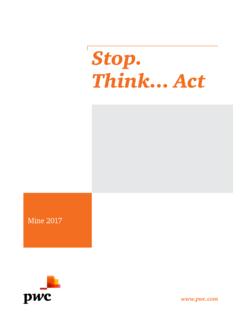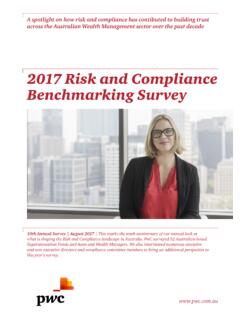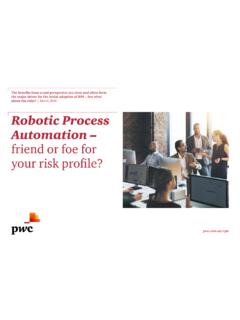Transcription of Assessing the risk of bribery and corruption (2016) (1) - PwC
1 Therisk of briberyand corruptionto your business2016 PricewaterhouseCoopers, ABN 52 780 433 757 Darling Park Tower 2, 201 Sussex Street, GPO BOX 2650, SYDNEY NSW 1171T +61 2 8266 0000, F +61 2 8266 9999, limited by a scheme approved under Professional Standards the risk of bribery and corruption to your businessBased on results from PwC s 2016 Global Economic Crime Survey (GECS), bribery and corruptioncontinues to rate in the top four economic crimes experienced by organisations globally, and lookingahead Australian organisations are predicting a higher likelihood of bribery and corruption over thenext two years when compared with the global average. We also know from PwC s 19th Annual GlobalCEO Survey that the percentage of chief executives naming bribery and corruption as one of the toprisks facing their organisation has experienced a significant increase recently, from 51% to 56%.
2 These results come off the back of highly publicised allegations and enforcement action reported inAustralian media, as Australia continues to slide down Transparency International s CorruptionPerception Index (now ranking 13thglobally). To combat this emerging concern, Boards and companyexecutives are increasingly looking to their internal teams to take greater responsibility for bothpreventing incidents of bribery and corruption and strengthening organisational resilience. Apragmatic first step in that process is conducting a bribery and corruption risk assessment, and thisdocument has been prepared to provide high level guidance for organisations starting down that don t hesitate to contact me on 02 82662993 or Mark Rigby on 02 82661774 if you would like todiscuss sincerely.
3 Malcolm ShackellPartnerForensic ServicesPwC1 Anti- bribery and corruptionContentsContents11 Introduction22 The legislative landscape43An effective anti- bribery and corruption framework64 Conducting a risk assessment8 Appendices10 Appendix ADeveloping and embedding an anti- bribery andcorruption framework11 PwC2 Anti- bribery and corruption1 IntroductionBackgroundBribery and corruption are by their nature deceptive and each act or instance of bribery or corruption can taint notonly the individuals involved but an entire organisation or process, sometimes long into the future. Globalregulations have long sought to negate the impacts of bribery and corruption in distorting markets, and theAustralian government, regulators and business community have endeavoured to keep pace with trends anddevelopments in order keep ahead of the risk curve.
4 In recent years we have seen the first real enforcementactions under Australian law and heard rumours of other enforcement action by the Australian Federal Police(AFP), which have occurred alongside major international legislative changes, such as the introduction of theUnited Kingdom bribery Act (UKBA). The growth of anti- corruption and corporate responsibility movements hasalso heightened business awareness of the obligations and risks posed, and made it imperative for organisations toquestion what they are doing to minimise their exposure to the risk of bribery and impacts of bribery and corruptionWithin the context of expanding markets, broader legislation and global financial pressures, the potential impactsof bribery and corruption are wide reaching and can include.
5 Convictions, fines and prison sentences for employees and officers Incurring substantial legal and professional fees, including increased cost of compliance through potentialregulatory response Significant reputational damage at a corporate, personal and governmental level Damage to the share price and loss of shareholder and other stakeholder confidence Distortion of the marketImplementing a frameworkIn reaction to this evolving landscape, Australian organisations have started to recognise the need to demonstratethat they have developed the key elements of a comprehensive program to minimise or reduce the risk of briberyand corruption , and have undertaken an appropriate risk organisations have a Code of Conduct and some form of training for new employees, along with policies andprocedures for managing important functions such as procurement and marketing.
6 However, it is crucial to bringthese elements together in order to implement a comprehensive bribery and corruption framework thatcommunicates to staff the importance of the organisation s stance against bribery and corruption and documenthow the organisation will mitigate the risks it and corruptionIdentifying the risks to your organisationA key component of an effective bribery and corruption framework is conducting a comprehensive risk assessmentto identify the specific risks the organisation is exposed to, or sometimes down to individual operating units in thecase of large businesses operating questions that organisations need to ask themselves include: How do we manage our third party service providers?
7 Are we using third parties to help expand into new markets? Do we deal with government officials? Are we facing business decisions where facilitation payments or bribes are expected? Do we do business overseas or are we considering overseas expansion?This document outlines key elements of the legislative landscape, the importance of having an anti- bribery andcorruption framework and how to approach conducting an effective risk assessment, including an example workplan to and corruption2 The legislative landscapeKey provisionsThe activities of Australian organisations are covered by the bribery of Foreign Public Officials Act and may befurther impacted by the Foreign Corrupt Practices Act (FCPA) and the UKBA if operating overseas.
8 Each of theseseparate pieces of legislation contain slightly different provisions, as detailed in the table below:Key considerationsAustraliaBribery of ForeignPublic Officials(1999)United KingdomUK bribery Act(2010)United StatesForeign CorruptionPractices Act (1977) bribery of foreign public officials covered?YesYesYesPrivate-to-private bribery covered?NoYesNoReceipt of a bribe covered?NoYesNoProof of intent required?YesMixedYesFacilitation payments permitted?YesNoYesPromotional expenses permitted?YesNoYesExtra territorial application?YesYesYesBribes through third parties covered?YesYesYesFailure to keep accurate books and recordscovered?YesYesYesIs failure to prevent bribery an offence?
9 NoYesNoCriminal penalties for individuals10,000 penalty units, 10year sentence or bothUp to 10 year sentenceand unlimited finesUp to $250,000 perviolation and sentencefor up to 5 yearsCriminal penalties for companies100,000 penalty units,3 times the benefit or10% of the turnoverUnlimited finesUp to $2,000,000 perviolationThe legislative landscapePwC5 Anti- bribery and corruptionThe UK bribery Act goes furtherThe UKBA criminalises bribery of both foreign public officials and individuals or companies, and has furtherpotential implications for organisations when compared with other existing legislation. The UKBA covers private-to-private bribery , facilitation payments and critically, introduces failure to prevent active bribery for or on behalfof the corporate body by its employees, agents or subsidiaries as an offence.
10 It does however outline that a defenceto the failure to prevent offence exists if it can be shown that adequate procedures were in the OECD Anti- bribery ConventionThe Phase 3 report on Australia by the Organisation for Economic Cooperation and Development (OECD)Working Group on bribery was issued in October 2012. The report evaluates and makes recommendations onAustralia s implementation and enforcement of the Convention on Combating bribery of Foreign Public Officialsin International Business Transactions and related instruments. The Working Group recommends that Australiareview its overall approach to enforcement in order to effectively combat international bribery of foreign publicofficials, which includes: Enhancing the usage of the corporate liability provisions, and where appropriate those on corporateculture, and providing on-going training to law enforcement authorities relating to the enforcement ofcorporate liability in foreign bribery cases.
